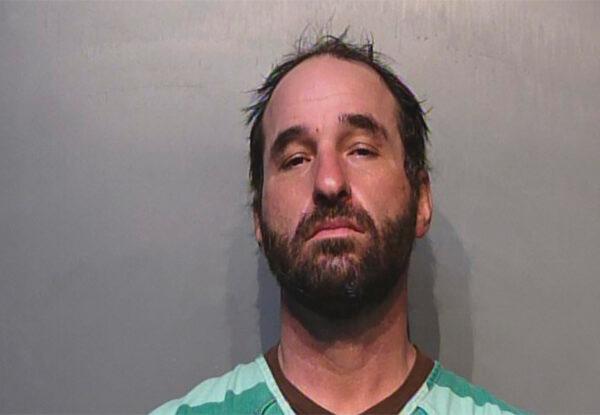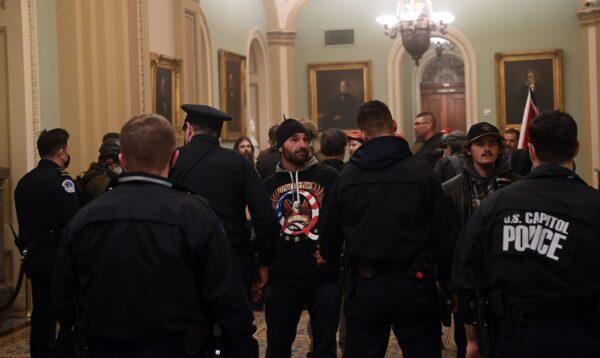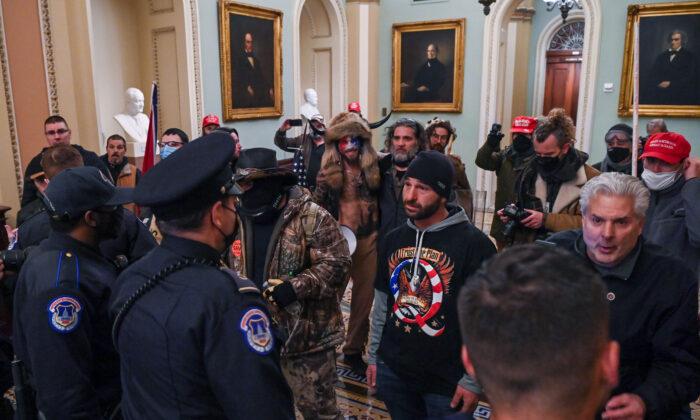A 41-year-old Iowa man has been found guilty by a Washington jury late on Sept. 23 on all seven charges related to the Jan. 6, 2021 breach of the Capitol building.
The seven counts that Douglas Jensen of Des Moines, Iowa, was found guilty of include five felonies. They are: obstruction of an official proceeding; assaulting, resisting, or impeding a law enforcement officer; obstructing a law enforcement officer during a civil disorder; entering and remaining in a restricted building or grounds with a dangerous weapon; and disorderly and disruptive conduct in a restricted building or grounds with a dangerous weapon. The dangerous weapon was a knife in Jensen’s pocket.
The other two counts the jury determined Jensen was guilty of are misdemeanor offenses: disorderly conduct in a Capitol building; and parading, demonstrating, or picketing in a Capitol building.
He is due to be sentenced on Dec. 16.
Jensen was reportedly a member of the group that chased U.S. Capitol Police officer Eugene Goodman near the Senate Chamber.
He was first arrested in Des Moines on Jan. 8, 2021, and had pleaded not guilty to all counts related to the Jan. 6 breach.

Disobeyed Orders From Police Officer
Prosecutors said Jensen was among the first 10 people who breached the Capitol on Jan. 6, 2021, after he had scaled the outer walls of the Capitol and climbed through a broken window to enter the building.At the time, Jensen was at the front of a crowd that was advancing further into a building in the Capitol complex, and repeatedly refused to comply with a lone Capitol Police officer on the day, who had ordered Jensen to stop, put his hands up, and back up, prosecutors said.
The officer retreated and eventually reached a staircase where he turned and ran up the flight of stairs in an attempt to get to back up, while Jensen advanced along with the crowd. The crowd stopped advancing after reaching an area where several more Capitol Police officers were present.
Jensen’s attorney, Christopher Davis, said during the jury trial that began Sept. 20 that no evidence, including video footage of Jensen on the day, shows the Jan. 6 defendant engaging in any violence or property damage.
“You will not see this man lay a hand on anyone,” Davis said of Jensen.

The Q movement, commonly referred to as QAnon, started on 4chan and 8chan message boards. Posts attributed to an anonymous figure named “Q” often alluded to government efforts to suppress individual freedoms and advance globalist agendas.
The Q posts attracted attention from a growing number of people with varying interpretations of the posts. Some people began to claim and believe that the posts suggested that certain members of the world’s social, economic, and political elites have engaged in egregious crimes, including child sex trafficking, abuse, and cannibalism.
Another notion that people who attribute their beliefs to Q promulgate is that former President Donald Trump was or is secretly fighting certain elite figures during his time in the White House, and that a so-called “Storm” that involved mass arrests was coming.
“[Jensen] was at the front of the crowd [on Jan. 6], but in no way leading anyone. He was in front of everyone for the now disclosed silly reason to get Q recognized for ‘The Storm’ that was about to take place,” Davis wrote in the court filing in June 2021.
“Six months later, languishing in a DC Jail cell, locked down most of the time, he feels deceived, recognizing that he bought into a pack of lies,” Davis wrote.

On Jan. 6, 2021, lawmakers gathered for a joint session of Congress to count and certify the electoral votes related to the 2020 presidential election. It was temporarily interrupted when a sizable group of protesters entered the building and its surrounds. Outside were thousands of other mostly peaceful protesters who had gathered in Washington on the day to express concerns about election integrity.
As of September, more than 870 people have been dealt charges accusing them of having committed federal crimes on Jan. 6, 2021. About 400 of them have pleaded guilty.
Juries have convicted eight Jan. 6 defendants after trials. None of the defendants who had jury trials was acquitted of any charges.




